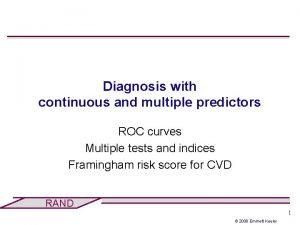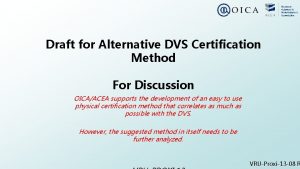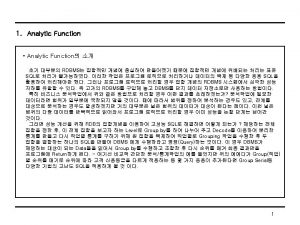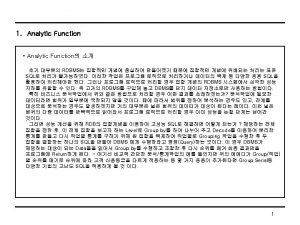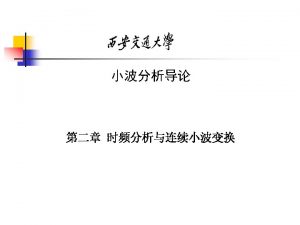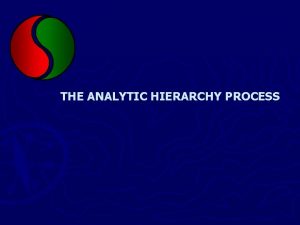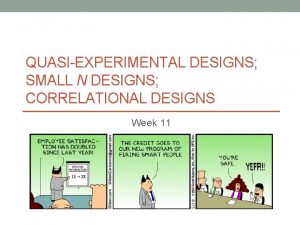Complex Analytic Designs Outcomes DVs Predictors IVs None














- Slides: 14

Complex Analytic Designs

Outcomes (DVs) Predictors (IVs) None 1 Category - 2 levels many levels 1 Continuous Many Continuous 1 Categorical Many Categorical (histogram) Factor Analysis: PCA, FA, CFA (MDS, CLAN) (frequencies) loglinear models c 2 tests for independence, loglinear & logit models loglinear models factorial Anova factorial Manova, repeated measures Manova, doubly multivariate designs (only for 2 -level DV’s: ) logit models, logistic regression loglinear models regression canonical correlation Discriminant Function Analysis, logistic regression factorial ANOVA in reverse interpretation canonical correlation, covariance structure analysis Discriminant Function Analysis, logistic regression factorial MANOVA in reverse interpretation t test Anova general Manova Many Categorical 1 Continuous Many Continuous multiple regression

ANOVA § “Factorial” = 2 or more factors that have at least 2 levels each § Example of a 2 x 2 design: Factor 1 Level 2 Factor Level A mean A 1 mean A 2 2 Level B mean B 1 mean B 2

Example Treatment Experimental Control Column Mean Main effect of Gender males 5 5 5 females 15 5 10 Row mean 10 5 7. 5 (grand mean) Main effect of Treatment Note: Cell means are a combined effect of row effects, column effects, the grand mean and the interaction.

Interactions Male teacher score C Main Effect Interaction A none B C Male teacher Female teacher Male Female D both one Male teacher yes Male Female no yes D score Male Female Design Female teacher score B score A Female teacher Male Female

More complex factorial designs § 2 factors, many levels: 3 x 2, 3 x 3, 6 x 8…. § >2 factors: 2 x 2 x 2, 3 x 4 x 2 § Nested designs: levels within levels § Repeated measures: multiple values per subject § Mixed (Between-within) designs: some factors are groups of different subjects and some are repeated measures on the same subjects

Mediators and Moderators A moderator is variable that affects the direction and/or strength of the relation between the IV and DV (i. e. sex, gender, level of reward) A mediator is a variable that accounts for the relation between the IV and DV.

Mediation Mediator b c Independent Dependent Variable a Criteria for mediator: Before mediator inclusion: path a is significant After mediator inclusion: paths b and c are both significant but a is not

Models and modeling § Hypothesize the data structure by specifying the model § “Fit” the data to the model § Test the fit of the data § Easiest example: simple regression is a linear model (i. e. is a straight line a good approximation of the data)

Regression on more than one IV § Predictor is a combination, typically linear (aka additive) of several IV. § Y = a + b. X 1 + b. X 2 + b. X 3 + …. + ε § Same principles apply, but also some new ones emerge…

X 1 Y Weak correlation Y Strong correlation X 1 X 2 Y X 1 X 2 X 3 Y X 3 Linear combination with multicolinearity

Hierarchical Regression § You can add or subtract terms to make a new model and test differences Model 1: Y = a + b. X 1 + ε Model 2: Y = a + b. X 1 + b. X 2 + ε R 2 change R 2 is the proportion (%) of variance in Y that is explained by the model. R 2 change is the proportion (%) of variance in Y that is explained by the model over and above the previous model.

Example: 1: adult depression teen depression 2: adult depression teen depression + stressful events Change in R 2 : proportion of variance in adult depression explained by stressful events after controlling for previous levels of depression Teen Depression Stressful events Adult Depression

What has not been covered § Use of categorical variables in regression (i. e. § § dummy coding) Loglinear analysis (linear contrasts of frequency data) and Discriminant Function Analysis (DFA). Person-centered approaches and cluster analysis Factor Analysis, Principle Components Analysis (PCA) Structural Equation Modeling (SEM), Hierarchical Linear Modeling (HLM), and other more difficult or esoteric analyses.
 Roc curve with multiple predictors
Roc curve with multiple predictors Dvs sistemos
Dvs sistemos Draft for discussion
Draft for discussion International valuation standards council
International valuation standards council Hdvr.ivs
Hdvr.ivs Ivs vs nature
Ivs vs nature Ivs benešov
Ivs benešov Simple compound and complex rules
Simple compound and complex rules Freud complexes
Freud complexes Simple compound complex and compound-complex sentences quiz
Simple compound complex and compound-complex sentences quiz The psychodynamic theory
The psychodynamic theory Droplet infection
Droplet infection Mbti percentages
Mbti percentages Classification of epidemiological studies
Classification of epidemiological studies Difference between descriptive and analytical epidemiology
Difference between descriptive and analytical epidemiology
